Today marks the 141th birthday of the late President Manuel L. Quezon, considered as the “Ama ng Wikang Pambansa.”
In the past, the country, particularly the schools, would celebrate August 13-19 as “Linggo ng Wika.” It was in 997 when then President Fidel Ramos issued Proclamation 1041 which makes the entire month a commemoration of “Buwan ng Wika.”
In schools today, toddlers and other students in other levels, garbed in “barongs” and “saya” and other clothes that would depict their being “Filipinos,” are made to participate in programs as part of recognizing the National Language.
But beyond the four corners of the classrooms and aside from the academicians, are there meaningful undertakings that show how the people love their supposed National Language? Considering that the country is not only archipelagic but that communities have their own supposed “mother tongue,” what is supposedly learned in school to unite the country has become a big tool also that divides it.
In the Visayas and Mindanao, for example, majority of the people speak Bisaya, not Pilipino, while most people in Luzon speak according to their regions as only those in the National Capital Region speak Pilipino, a language which people equate to Tagalog.
There is also a misplaced notion, dependent on who harbors what, that either those who speak Pilipino are superior than those who do not, or vice versa.
Indeed, in a country characterized by diversity, a common language is far from bringing unity among its people. So what now?




